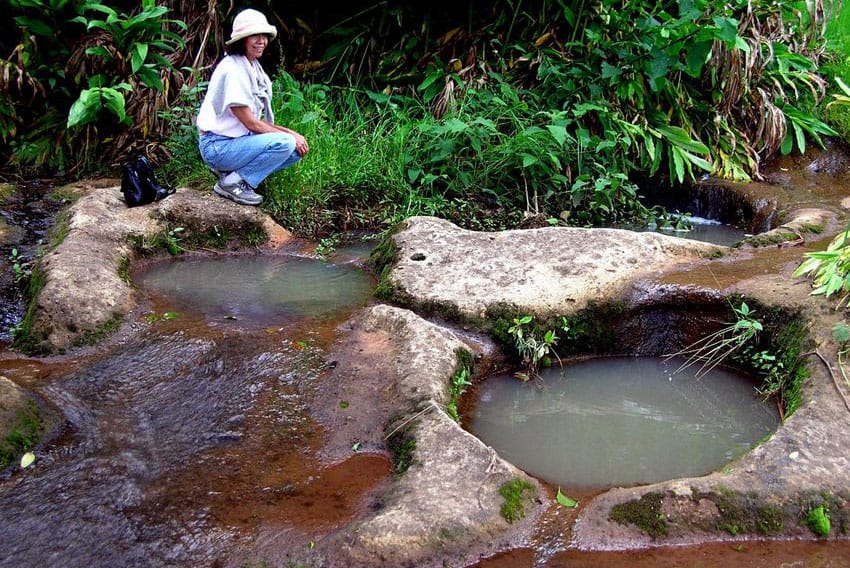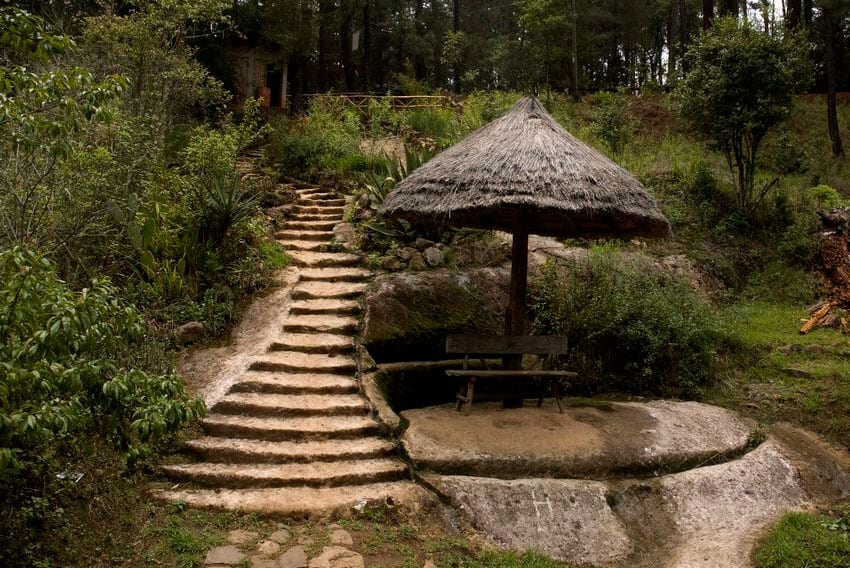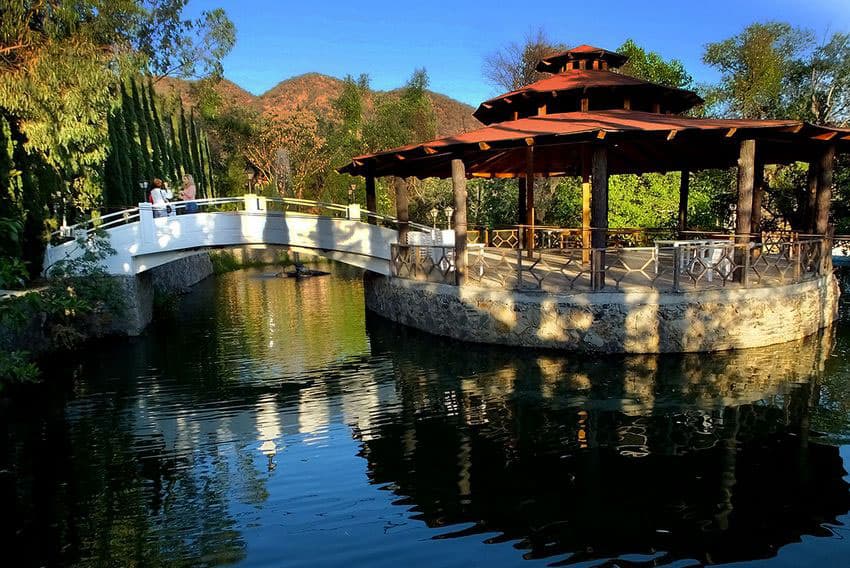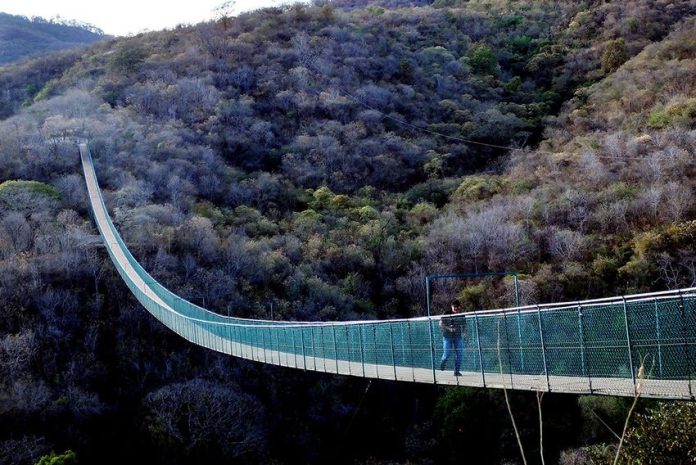Mazamitla, Jalisco, is one town that really deserves the name Pueblo Mágico. The quaint streets, the delightful balconies, the beautiful pagoda-like church, the incredibly delicious food, a night before a crackling fireplace with a ponche de pasiflora in hand . . . what more could you ask?
Well, I’m always looking for interesting outdoor sites I can visit the morning after. One such place is the community of Los Cazos just southwest of Mazamitla.
The name Los Cazos refers to “large cauldrons” carved in the bedrock of a small river on the premises. I had heard about the place but hadn’t bothered to check it out until I came upon what seems to be Mexico’s oldest tequila distillery near the town of Amatitán in Jalisco.
Among the ruins of Taberna El Tecuane, I was amazed to see that the fermentation of the sweet mosto took place in 44 huge holes carved into the living rock, each of these giant pots holding around 3,000 liters.
Could the great stone cauldrons of Los Cazos have been carved for a similar purpose? Local archaeologist Phil Weigand told me it was quite likely and off I went to have a look.

The housing development of Los Cazos is located two kilometers straight southwest of Mazamitla.
Outside the entrance to this little community, we found a confusion of horses, caballeros and cuatrimotos (four-wheeled all-terrain vehicles). Apparently, Los Cazos and the surrounding area is so attractive that lots of people are quite happy to rent either a quiet horse or a noisy ATV to explore the network of cobblestone roads which wind through these pine-covered hills.
Seeing all this, we suspected that we would not be allowed to drive our car into Los Cazos, but such was not the case at all. As long as you pay a fee of 12 pesos per person, you may enter the fraccionamiento (between 9:00am and 5:00pm), no matter whether the vehicle carrying you has wheels or legs.
We parked 500 meters south of the gate and walked downhill to a charming wooden footbridge crossing a stream. This is the start of what they call the Enchanted Garden, a series of bridges, narrow paths and small waterfalls which follow the stream downward.
From the first bridge you’ll have a great view of the Cazos, big holes carved in the soft rock of the stream bed. Some of these are round and some are rectangular. They come in a variety of sizes and may be up to a meter deep. The rock is a kind of rhyolite, locally known as tepetate, the very same material in which Indians carved the fermentation pots at El Tecuane.
Hand-carved channels a few inches deep permit water to flow in and out of each cauldron and in many cases there are bypass channels alongside the pots. By blocking or unblocking the channels, one could easily fill a pot with water and then “turn off” the water supply. Although the Cazos were probably used to ferment mezcal, on a nice hot day you could also use them as mini-swimming pools.

One kilometer southwest of the fermentation pots, you’ll find a 30-meter-high waterfall which, like 90% of the falls in Mexico, is locally known as El Salto (The Jump). This one has a steep trail which takes you down to the bottom in eight minutes, and is relatively easy to negotiate thanks to the addition of crude stairs here and there.
If you want to frolic in the shallow pool beneath the falling water, there appear to be no regulations to the contrary and the local people say the water is pure and clean. Back up at the top of the fall, you can cross the stream via a little bridge and check out a cliff-hanging trail that leads to a good spot for photographing the cascading water from above. For more information Google Fraccionamiento Los Cazos en Mazamitla Jalisco.
On a recent visit to charming Mazamitla, I found another nearby site well worth visiting. It’s called Mundo Aventura, but don’t be fooled by the name: even though it has lots of attractions for kids, it’s a place that visitors of all ages will appreciate.
This I think is due to the fertile imagination of the man who built it, Rafael Pulido, who was enchanted by its magnificent waterfall, plunging 150 meters to the bottom of a deep, wooded canyon, which he was convinced could only be appreciated properly from a colossal hanging bridge stretched over it.
Few would have had the persistence to turn such a dream into reality, but Pulido did it. His bridge is a whopping 350 meters long and possibly the longest hanging bridge in the Americas. Of course, claims of biggest, smallest or whatever are not easy to verify, but I can assure you this particular hanging bridge is spectacular and walking across it is an experience you are unlikely ever to forget.
Another feature of this place which I find fascinating is a sort of Labyrinth of Standing Stones, another creation of Rafael Pulido, consisting of flat blades of shale which stand up to three meters tall, resulting in a strange and beautiful garden.

Anyone interested in crossing the canyon while whizzing through the air can do so on a zip line a full kilometer and a half long, one of the longest in the world, in fact. As far as I could determine, it appears to be the second-longest zip line in Latin America, right behind Brazil’s Mega Tirolesa Pedra Bela which is 1,900 meters long.
For those who prefer a less speedy way to cross the canyon, Mundo Aventura also has three shorter zip lines that will do the trick.
When you are tired of watching people zipping along all these tirolesas, you can retreat to a quiet lake on the property with a picturesque island in the middle.
I asked Señor Pulido’s daughter Rosalinda to tell me a little about the origins of Mundo Aventura.
“This is a family business,” she told me. “We are 11 brothers and sisters. Everything we have created here is thanks to our father, who is a visionary. He had no money and no education, but he traveled the world with a knapsack on his back.
“In Canada he saw the famous Capilano hanging bridge and instantly knew this was what he wanted to span the deep canyon here. So, 28 years ago my father set out to create . . . well, not just any park, his aim has always been to create the best park in the world! However, people told him he was crazy and no tourists would every come to a place like this in the middle of nowhere.
[soliloquy id="88740"]
“Then, our house burned down, and there we were out on the street. But nothing could stop my father and six months later we opened Mundo Aventura . . . and from that moment on we’ve always had crowds of people coming here.”
Rafael Pulido was convinced people from Guadalajara would flock to his park to escape the stresses of the big city and, his daughter told me, the park now sees over 3,000 visitors per day during peak periods like Easter Week.
“And we have had guests from as far away as India, France, the U.S.A. and England,” Rosalinda Pulido proudly stated.
Mundo Aventura is open every day of the year from 9:00am to 8:00pm. For more information see their web page. To get there, set your navigator for Mundo Aventura Jalisco.
The writer has lived near Guadalajara, Jalisco, for more than 30 years and is the author of A Guide to West Mexico’s Guachimontones and Surrounding Area and co-author of Outdoors in Western Mexico. More of his writing can be found on his website.
